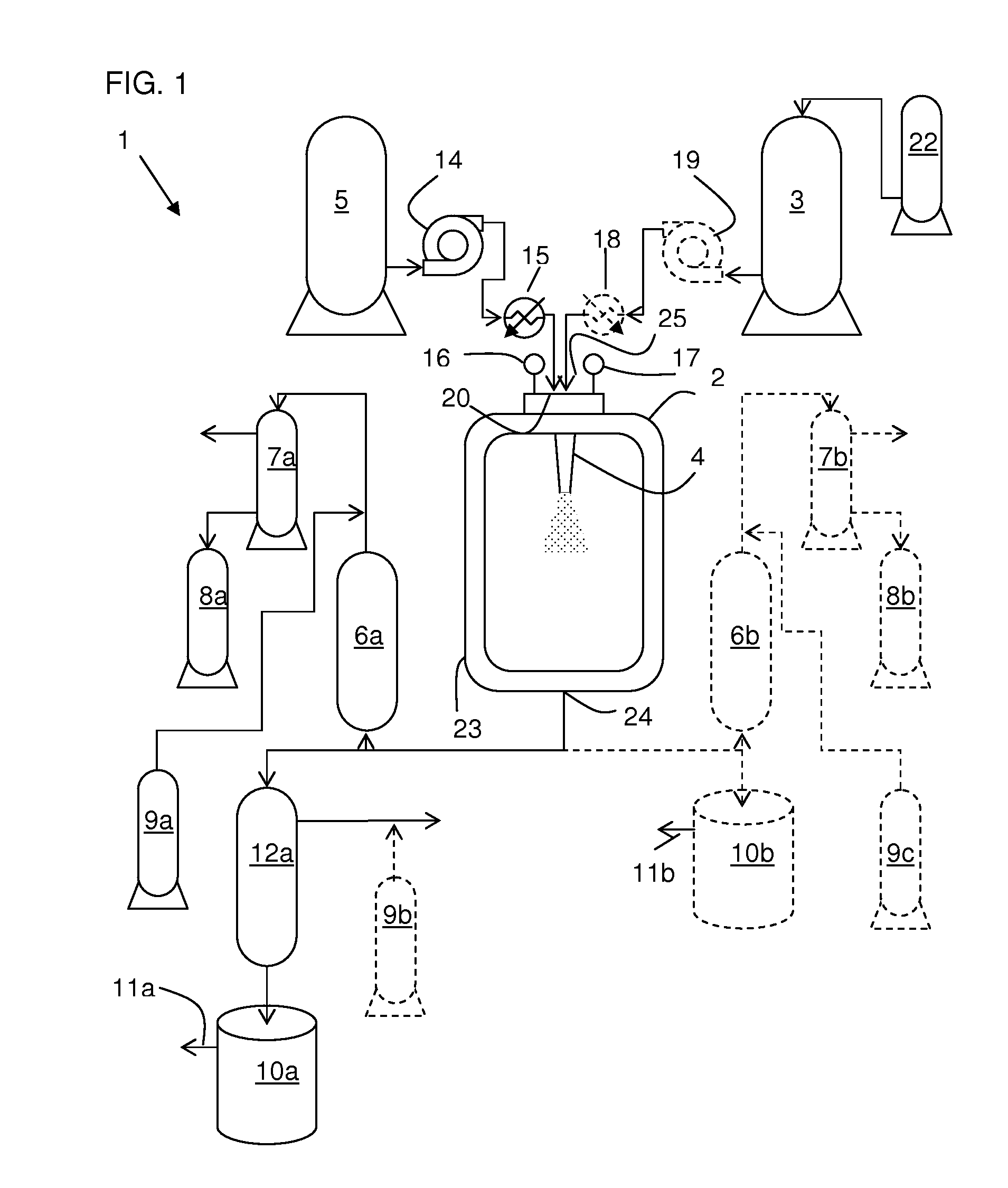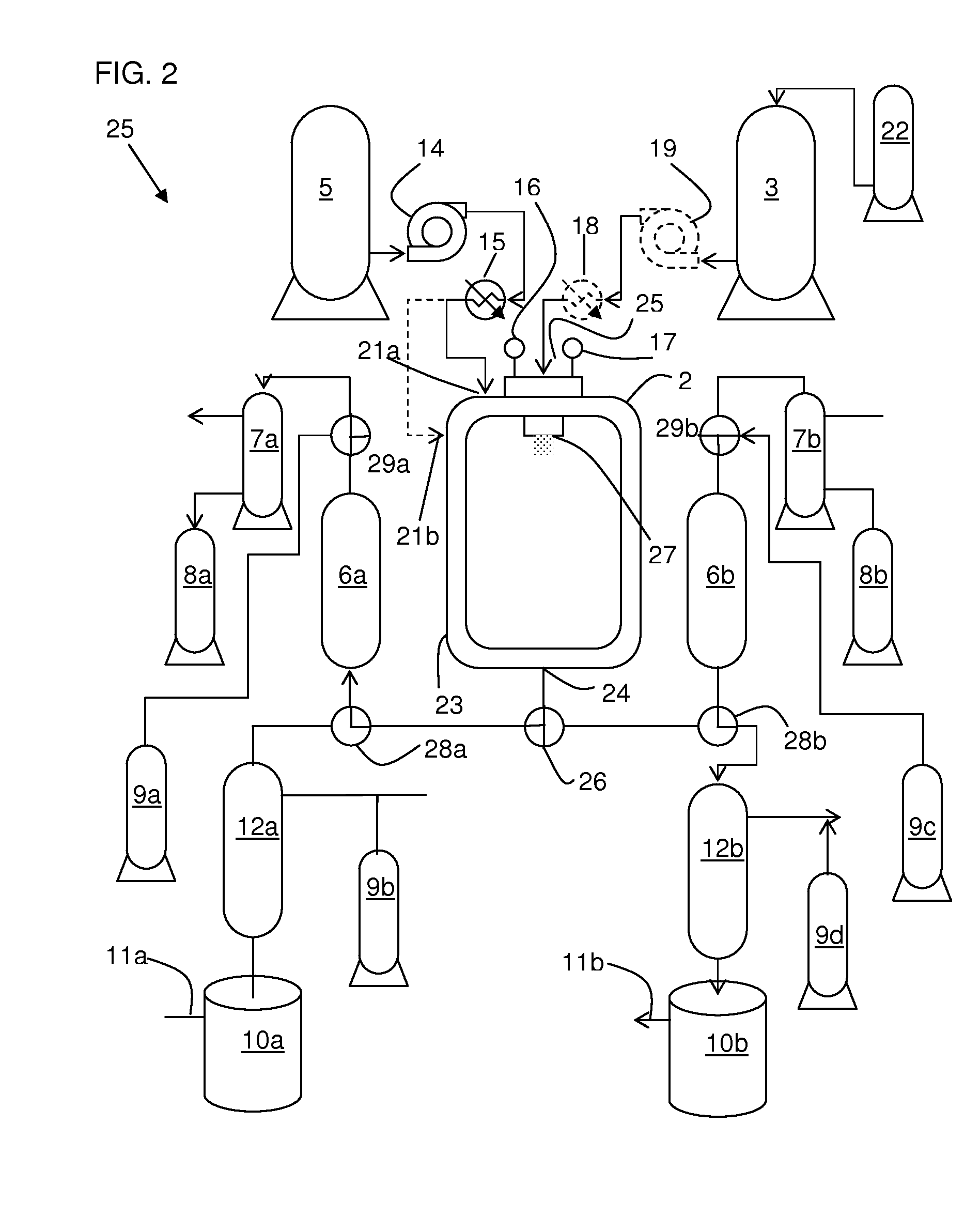Equipment Assembly for and Method of Processing Particles
a technology of equipment and particles, applied in the field of apparatus for processing particles, can solve the problems of entrapment of solvent and/or anti-solvent within and/or on the surface of particles, more difficult to remove, and increase the difficulty of particle anti-solvent saturation
- Summary
- Abstract
- Description
- Claims
- Application Information
AI Technical Summary
Benefits of technology
Problems solved by technology
Method used
Image
Examples
example 1
[0107]The following process can be used to make particles comprising acetaminophen. The following ingredients in the amounts indicated are used.
INGREDIENTAMOUNT (% WT.)Acetone96.5acetaminophen3.5
[0108]An equipment assembly as depicted in FIG. 5 is employed. A process fluid is prepared by dissolving acetaminophen in ethanol in amounts according to the table above. Dissolution can be done while heating and / or mixing. The anti-solvent is supercritical carbon dioxide (scCO2).
[0109]The precipitation chamber is charged with scCO2 and its temperature and pressure are equilibrated. The pressure is about 1,200 psi and the temperature is about 38° C. Flow of scCO2 through the precipitation chamber is initiated. Clean solvent is conducted through an atomizer, comprising a vibrating porous mesh and a capillary nozzle upstream of the mesh, by way of an inlet in the precipitation chamber, whereby it is atomized directly into the scCO2. The flow rate (about 730 ml / min) of scCO2 into the chamber ex...
example 2
[0112]The following process can be used to make particles comprising paclitaxel and PLGA (poly-(lactic acid)-co-(glycolic acid) polymer). The following ingredients in the amounts indicated are used.
INGREDIENTAMOUNT (% WT.)Acetone96Paclitaxel2.5PLGA1.5
[0113]The process of Example 1 is followed with the following exceptions.
[0114]The process fluid is prepared by dissolving paclitaxel and PLGA in acetone in amounts according to the table above.
example 3
[0115]The following process can be used to make particles comprising meloxicam. The following ingredients in the amounts indicated are used.
INGREDIENTAMOUNT (% WT.)Acetone:DMF 20:8096.8meloxicam3.2
[0116]An equipment assembly as depicted in FIG. 5 is employed. A process fluid is prepared by dissolving meloxicam in acetone / dimethylformamide (20:80) in amounts according to the table above. Dissolution can be done while heating and / or mixing. The anti-solvent is supercritical carbon dioxide (scCO2).
[0117]The precipitation chamber is charged with scCO2 and its temperature and pressure are equilibrated. The pressure is about 1,200 psi and the temperature is about 38° C. Flow of scCO2 through the precipitation chamber is initiated. Clean solvent is conducted through an atomizer, comprising a vibrating porous mesh and a capillary nozzle upstream of the mesh, by way of an inlet in the precipitation chamber, whereby it is atomized directly into the scCO2. The flow rate (about 730 ml / min) of s...
PUM
| Property | Measurement | Unit |
|---|---|---|
| diameter | aaaaa | aaaaa |
| outer diameter | aaaaa | aaaaa |
| pressure | aaaaa | aaaaa |
Abstract
Description
Claims
Application Information
 Login to View More
Login to View More - R&D
- Intellectual Property
- Life Sciences
- Materials
- Tech Scout
- Unparalleled Data Quality
- Higher Quality Content
- 60% Fewer Hallucinations
Browse by: Latest US Patents, China's latest patents, Technical Efficacy Thesaurus, Application Domain, Technology Topic, Popular Technical Reports.
© 2025 PatSnap. All rights reserved.Legal|Privacy policy|Modern Slavery Act Transparency Statement|Sitemap|About US| Contact US: help@patsnap.com



